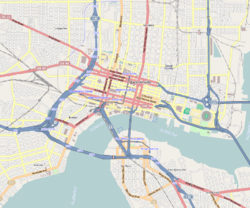History
The roots of MOSH go back to 1941 when the Jacksonville Children's Museum was chartered. [4]
The first permanent home was a Victorian mansion in Riverside. Construction began on the current city-owned location downtown in 1965, and the facility opened in 1969. The Jacksonville Children's Museum became the Jacksonville Museum of Arts and Sciences in 1977 and six years later, they were accredited by the American Alliance of Museums. [5]
The name was changed to Museum of Science and History in 1988 and 37,500 square feet (3,480 m2) of space was added, including the planetarium then known as the Alexander Brest Planetarium. The last building renovation occurred in 1994 resulting in a total of 82,200 square feet (7,640 m2). In 2010 the Planetarium was upgraded with a new projector, sound system, and interior work, and renamed the Bryan-Gooding Planetarium. [3]
The most recent accreditation by the American Alliance of Museums was in 2011. [5] In 2013, the museum opened a new core exhibit, JEA PowerPlay: Understanding Our Energy Choices and the newly renovated JEA Science Theater. In 2016, the museum opened another new core exhibit, Health in Motion: Discover What MOVES. [6]
Genesis Project
In 2021, MOSH announced it would relocate to the Northbank of downtown Jacksonville with a new facility designed by architectural firm DLR Group. [7] The new facility would increase the museum's space to 133,000 square feet (12,400 m2). [8]
In March 2025, the Jacksonville City Council approved an amended agreement allowing construction of a new building and surrounding park, with the city providing funding for park design, roadway and utility improvements, and a section of the Northbank Riverwalk. MOSH will enter a 40-year nominal lease for the city-owned building, paying $1 per year. By May 2025, MOSH reported raising over $95 million in private donations and stated the facility would create seven acres of indoor-outdoor learning experiences. [9]
Closure
In early May 2025, MOSH CEO Dr. Alistair Dove announced that the facility would close on August 31, 2025. Construction at the new location was expected to begin in early 2026 and take 18 months to complete. Dove described the existing museum as "an aging cultural facility" and noted that the transition required focusing resources on planning the new museum rather than operating the old one. Museum members were encouraged to visit NARM- or ASTC-affiliated museums at no cost. [10]
The MOSH Southbank building closed on September 1, 2025, as the museum prepared to relocate to the proposed Northbank facility. The city-owned site is under review for demolition, with ELEV8 Demolition contracted to remove the structure. Staff of Jacksonville's Downtown Investment Authority determined the building was not salvageable, and the site is expected to be cleared for future development. [9]
This page is based on this
Wikipedia article Text is available under the
CC BY-SA 4.0 license; additional terms may apply.
Images, videos and audio are available under their respective licenses.


